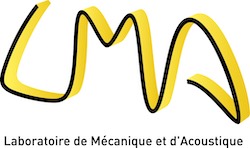Coworkers
Muttalip Temiz*, Ines Lopez-Arteaga* and Avraham Hirschberg$* Eindhoven University of Technology, Department of Mechanical Engineering, The Netherlands
$
Eindhoven University of Technology, Department of Applied Physics, The Netherlands
Abstract
One can blow out a candle by placing the flame just in front of the tone-hole of a clarinet played loudly. This is due to periodic vortex shedding at the tone-hole as a result of separation of the outgoing acoustic flow passing through the tone-hole. The same occurs inside the tube during inflow. This inflow of fresh air from outside the tube is actually responsible for a local reduction of the air temperature near an open tone- hole in a clarinet tube [1]. This non-linearity also explains the behavior of a thin walled clarinet as designed by Benade and Keefe [2]. This thin walled clarinet with the same linear impedance as a thick walled equivalent instrument will not play. This is explained by the reduced diameter of the tone-holes, which increases the local acoustic flow velocity at constant pressure level in the instrument. A quasi-steady model [3] for the tone-hole response provides a qualitative explanation [4].Experimental evidence for the non-linear transfer impedance of an orifice has already been provided by Ingard et al. [5,6]. He distinguished a first non-linear regime (I) in which vortices that are formed due to flow separation at edges of the orifice, remain close to this edge from a second regime (II) in which the vortex ring separates from the edge and travels as a result of self-induced velocity [5]. The transition from first to second regime was observed at an open-pipe termination by Atig et al. [7] and Buick et al. [8]. Disselhorst and Van Wijngaarden [9] and Peters and Hirschberg [10] propose simplified models for pipe terminations with thin walls (sharp edges).
The present study provides some information on the transition regime between regimes I and II. The data is presented as a function of the dimensionless parameters Strouhal number St and Shear number Sh. The Strouhal number is the ratio of the tone-hole diameter to amplitude of air particle displacement. The shear number is the ratio of the tone-hole diameter and the Stokes viscous boundary layer thickness. For conditions in musical instruments the Strouhal number is the most important parameter. The non-linear part of the transfer impedance can be approximated by a function of the Strouhal number.
References
[1] Noreland D., An experimental study of temperature variations inside a clarinet, Proceedings of the Stockholm Music Acoustics Conference 2013, SMAC 2013, Stockholm, Sweden, paper 446.
[2] Keefe D.H. Acoustic streaming, dimensional analysis of nonlinearities, and tone hole mutual interactions in woodwinds, J. Acoust. Soc. Am. 73 (1983) 1804-1820
[3] Cummings A., Acoustic nonlinearities and power losses at orifices, AIAA Journal, 22 (1984) 786-792.
[4] Dalmont J.-P., Nederveen C.J., Dubos V., Olivier S., Meserette V., Sligte E.T., Experimental determination of the equivalent circuit of an open side hole : Linear and non linear behavior, Acta Acustica United with Acustica 88 (2002) 567-575.
[5] Ingard U. and Labate S., Acoustic circulation effects and the nonlinear impedance of orifices, J. Acoust. Soc. Am. 22 (1950) 211-218..
[6] Ingard U. and Ising H., Acoustic nonlinearity of an orifice, J. Acoust. Soc. Am. 42 (1967) 6-17.
[7] Atig M., Dalmont J.-P., Gilbert J., Saturation mechanism in clarinet-like instruments, the effect of the localized non-linear losses, Applied Acoustics 65 (2004)1133-1154.
[8] Buick J.M., Atig M. Skulina D.J., Investigation of non-linear acoustic losses at the open end of a tube, J. Acoust. Soc. Am. 129 (2011) 1261-1272
[9] Disselhorst J. H.M. and Van Wijngaarden L., Flow in the exit of open pipes during acoustic resonance, J. Fluid Mech., 99 (2) (1980), pp. 293–319
[10] Peters M.C.A.M. and Hirschberg A., Acoustically Induced Periodic Vortex Shedding At Sharp Edged Open Channel Ends : Simple Vortex Models, J. Sound and Vibration 161 (1993) 281-299


